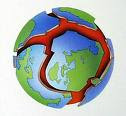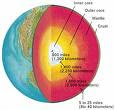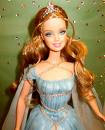
Friday, October 5, 2007
ABOUT THE EARTH!
Like all the other planets in the Solar System, the Earth is thought to have formed at the same time as the Sun, some four and a half billion years ago. Colliding asteroids formed the beginnings of an early planet, and its gravitational pull continued to attract solid material towards it.
As the Earth grew in size, so the strength of its gravitational field increased. More and more collisions took place with greater amounts of energy. This made the Earth's surface heat up, to the point where it began to melt. This melting resulted in the layered structure we see within the Earth today, with the formation of a core, mantle and crust.
The separating out of the structure of the Earth was probably the most significant event in the formation of the planet. Not only did it lead to the creation of the crust and the continents, but also the atmosphere and the oceans.
The Earth looks very different today to how it once did. The surface used to be littered with active volcanoes and, with no ozone layer, the atmosphere had no protection from the Sun. Over millions of years, though, the planet cooled and the water in the atmosphere settled to form the oceans in which life began.
As the Earth grew in size, so the strength of its gravitational field increased. More and more collisions took place with greater amounts of energy. This made the Earth's surface heat up, to the point where it began to melt. This melting resulted in the layered structure we see within the Earth today, with the formation of a core, mantle and crust.
The separating out of the structure of the Earth was probably the most significant event in the formation of the planet. Not only did it lead to the creation of the crust and the continents, but also the atmosphere and the oceans.
The Earth looks very different today to how it once did. The surface used to be littered with active volcanoes and, with no ozone layer, the atmosphere had no protection from the Sun. Over millions of years, though, the planet cooled and the water in the atmosphere settled to form the oceans in which life began.
Thursday, October 4, 2007
INTERACTION
The interaction of the Earth and the Moon slows the Earth's rotation by about 2 milliseconds per century. Current research indicates that about 900 million years ago there were 481 18-hour days in a year.
EARTH'S ATMOSPHERE
The Earth's atmosphere is 77% nitrogen, 21% oxygen, with traces of argon, carbon dioxide and water. There was probably a very much larger amount of carbon dioxide in the Earth's atmosphere when the Earth was first formed, but it has since been almost all incorporated into carbonate rocks and to a lesser extent dissolved into the oceans and consumed by living plants.
WATER ON EARTH!
71 Percent of the Earth's surface is covered with water. Earth is the only planet on which water can exist in liquid form on the surface. Liquid water is, of course, essential for life as we know it.
PLATES
Unlike the other terrestrial planets, Earth's crust is divided into several separate solid plates which float around independently on top of the hot mantle below.
There are (at present) eight major plates:
•North American Plate - North America, western North Atlantic and Greenland
•South American Plate - South America and western South Atlantic
•Antarctic Plate - Antarctica and the "Southern Ocean"
•Eurasian Plate - eastern North Atlantic, Europe and Asia except for India
•African Plate - Africa, eastern South Atlantic and western Indian Ocean
•Indian-Australian Plate - India, Australia, New Zealand and most of Indian Ocean
•Nazca Plate - eastern Pacific Ocean adjacent to South America
•Pacific Plate - most of the Pacific Ocean (and the southern coast of California!)
There are also twenty or more small plates such as the Arabian, Cocos, and Philippine Plates.
There are (at present) eight major plates:
•North American Plate - North America, western North Atlantic and Greenland
•South American Plate - South America and western South Atlantic
•Antarctic Plate - Antarctica and the "Southern Ocean"
•Eurasian Plate - eastern North Atlantic, Europe and Asia except for India
•African Plate - Africa, eastern South Atlantic and western Indian Ocean
•Indian-Australian Plate - India, Australia, New Zealand and most of Indian Ocean
•Nazca Plate - eastern Pacific Ocean adjacent to South America
•Pacific Plate - most of the Pacific Ocean (and the southern coast of California!)
There are also twenty or more small plates such as the Arabian, Cocos, and Philippine Plates.
DO YOU KNOW?
Most of the mass of the Earth is in the mantle, most of the rest in the core.
The core is probably composed mostly of iron (or nickel/iron) though it is possible that some lighter elements may be present, too. Temperatures at the center of the core may be as high as 7500 K, hotter than the surface of the Sun.
The Earth is the densest major body in the solar system
The core is probably composed mostly of iron (or nickel/iron) though it is possible that some lighter elements may be present, too. Temperatures at the center of the core may be as high as 7500 K, hotter than the surface of the Sun.
The Earth is the densest major body in the solar system
Subscribe to:
Comments (Atom)




